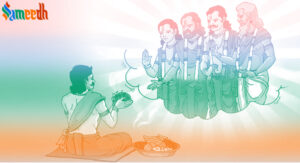The Mahalaya Shradh Mantra is a sacred mantra recited during the Shradh ceremony, particularly during the Mahalaya period, which marks the beginning of the Pitru Paksh. This mantra is chanted to invoke the blessings of the ancestors and seek their peace and well-being in the afterlife.

Here is the Mahalaya Shradh Mantra:
“ॐ आप्यायन्तु ममाङ्गानि वाक्प्राणश्चक्षुः श्रोत्रमथो बलमिन्द्रियाणि च सर्वाणि ।
सर्वं ब्रह्मौपनिषदं माऽहं ब्रह्म निराकुर्याम् मा मा ब्रह्म निराकरोदनिराकरणमस्त्वनिराकरणं मेऽस्तु
तदात्मनि निरते य उपनिषत्सु धर्मास्ते मयि सन्तु ते मयि सन्तु ।
ॐ शान्तिः शान्तिः शान्तिः ॥”
Here is the transliteration of the mantra:
“Om Apyayantu mamangani vakpranashchakshuh shrotramatho balamindriyani cha sarvani |
Sarvam brahmaupanishadam ma aham brahma nirakuryam ma ma brahma nirakarodanirakaranamastvanirakaranam me’ astu |
Tadaatmani nirate ya upanishatsu dharmaste mayi santu te mayi santu |
Om Shantih Shantih Shantih ||”
Translation:
“May all my limbs, speech, vital force, eyes, ears, strength, and all the senses be nourished. All is the Absolute Brahman (the Supreme Reality) as described in the Upanishads. May I never deny Brahman, nor Brahman deny me. Let there be no denial at all. May all the virtues declared in the Upanishads be present in me, who am devoted to the Atman (the Self). May they reside in me. May they reside in me. Om, peace, peace, peace.”
Performing the Mahalaya Shradh Mantra involves chanting the sacred mantra with devotion and sincerity while offering prayers and offerings to one’s ancestors. Here’s a step-by-step guide on how to perform the Mahalaya Shradh Mantra:
- Preparation: Begin by preparing for the Shradh ceremony by cleaning the area where the rituals will be performed. Set up a clean space, preferably facing east or north, and arrange the necessary items for the ritual, including offerings like food, water, flowers, and incense.
- Invocation: Start the ceremony by invoking the presence of the divine and seeking the blessings of Lord Vishnu or Lord Shiva, who are often invoked as the presiding deities of the ancestors. Light a lamp or candle as a symbol of divine illumination.
- Recitation of the Mantra: Begin chanting the Mahalaya Shradh Mantra with devotion and sincerity. The mantra is as follows:
“ॐ आप्यायन्तु ममाङ्गानि वाक्प्राणश्चक्षुः श्रोत्रमथो बलमिन्द्रियाणि च सर्वाणि ।
सर्वं ब्रह्मौपनिषदं माऽहं ब्रह्म निराकुर्याम् मा मा ब्रह्म निराकरोदनिराकरणमस्त्वनिराकरणं मेऽस्तु
तदात्मनि निरते य उपनिषत्सु धर्मास्ते मयि सन्तु ते मयि सन्तु ।
ॐ शान्तिः शान्तिः शान्तिः ॥”
- Offerings: While chanting the mantra, offer prayers and offerings such as food, water, flowers, and incense to the ancestors. Offer these items with reverence and devotion, seeking the blessings of the departed souls.
- Prayers and Intentions: Along with the mantra chanting and offerings, offer prayers and express gratitude to the ancestors for their blessings and guidance. Seek their blessings for the well-being, prosperity, and happiness of the family.
- Conclusion: Conclude the Mahalaya Shradh Mantra recitation and offerings with a final prayer for peace and harmony. Offer prostrations or bow down in reverence to the divine and the ancestors.
- Observance: Perform the Mahalaya Shradh Mantra recitation and offerings daily during the Mahalaya period, especially on significant days like Amavasya (new moon day) or other auspicious days associated with ancestral worship.
It’s essential to perform the Mahalaya Shradh Mantra with sincerity, devotion, and reverence, seeking the blessings of the ancestors and honoring their memory with humility and gratitude.
This mantra is recited with devotion and sincerity during the Shradh ceremony to honor and seek the blessings of the departed ancestors, ensuring their peace and well-being in the afterlife.
